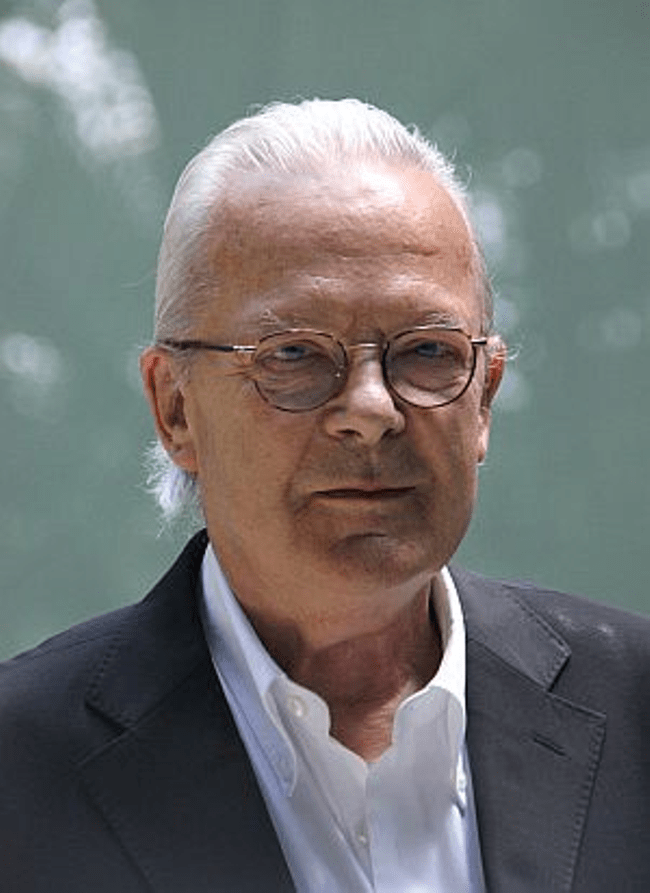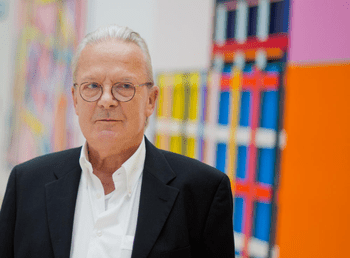Imi Knoebel
One of the leading German artists of the post-war period, Imi Knoebel's wide-ranging and rigorous oeuvre incorporates drawing, painting, sculpture, photography, projections and installation.

Works
Unique
Biography

Imi Knoebel
One of the leading German artists of the post-war period, Imi Knoebel's wide-ranging and rigorous oeuvre incorporates drawing, painting, sculpture, photography, projections and installation.
Born as Klaus Wolf Knoebel in Dessau in 1940 he studied under the tutelage of Joseph Beuys at the Düsseldorf Art Academy and was assigned, together with his friend Imi Giese, its legendary “Raum 19”.
Knoebel's art is resolutely abstract, continuing Malevich's notion of “pure perception” through the exploration of form, colour and material. “When I am asked about what I think when I look at a painting” he has said, “I can only answer that I don't think at all; I look at it and can only take in the beauty, and I don't want to see it in relation to anything else. Only what I see, simply because it has its own validity.” Often producing work in groups or series, his minimal compositions rely on a pared down, strict vocabulary of forms combined with a subtle and commanding use of colour, exposing the physical possibilities inherent in the most basic of materials, such as plywood, aluminium and fibreboard. This is exemplified by the large installation Raum 19, created while Knoebel was still a student under Joseph Beuys and now part of Dia Beacon’s permanent collection. Borrowing its title from the number of his studio at the Kunstakademie, it consists of 184 wood and fibreboard forms such as frames or stretchers, cylinders, cubes and rectangles which can be stacked, layered and reconfigured in any number of different ways. Unpainted and left in their raw material state, this constellation of neutrally coloured, humble components suggests both the potential for future use as well as the reduction of art to its basic material elements.
Knoebel first began making paintings in the 1960s with the strict and basic organising principle of thick or thin vertical lines drawn at variable distances from each other. Between 1966-73 he produced around 250,000 A4 pencil line drawings, and exhibited them in six high and narrow steel cupboards, hermetically sealed and accessible only on demand. He further dematerialised the medium of painting altogether by simply projecting lines, squares or crosses onto internal or external walls. This reductive approach to painting continued into a series of black and white abstract works that played with combinations of rectangular forms. Since the mid 1970s and especially following the death of his friend Blinky Palermo, Knoebel began to systematically experiment with colour, the expansive painting series 24 Farben – für Blinky (1977) marking the beginning of this process. During the 1980s, he incorporated found objects into his installations and constructions in works such as Eigentum Himmelreich (Property kingdom of heaven,1983) which consists of 18 separate objects and is dedicated to his friend and fellow artist Imi Giese (1942-1974).
Knoebel's work exhibits a tension between materiality and immateriality evident in his white-on-white projections, plywood or 'sandwich pictures' and white paintings. The white Drachen (kite) series, for example, are quadrilateral-shaped works placed high up, as if floating, and barely visible on the gallery wall. In the plywood paintings he extends the form of a two dimensional painting into three dimensional space through a process of invisibility or concealing. Painted on one side and sandwiched together with their colour side facing inwards, the only trace of the colour existing is through its drips or residue around the edges of the work. These sculptural paintings enact a pictorial denial, relying instead on the viewer's projection or knowledge that the colour exists, creating a sense of encounter through a literal internalization of painting.
Since the 1990s, Knoebel has used aluminium as a painting ground, cut-out and painted in single colours, such as in the series of primary coloured paintings titled Ich Nicht (Not me) (2006), an homage to Barnett Newman's key work Who's Afraid of Red, Yellow and Blue. In recent works (2014-2015) Knoebel has combined organic and geometric shaped panels in combinations of two or three colours, occasionally adding in a phosphorescent effect that soaks, stores and emits the surrounding light. In these paintings, Knoebel explores formal contrasts such as hard-edged with soft, coloured with neutral and matt with reflective to vivid effect. Knoebel incorporates architectural motifs into recent compositions, such as window or door-shaped sections of wood, as well as sections of mirror that partially include the surrounding gallery architecture into their pictorial field. In other works, painting is expanded to an architectural scale with large panels of aluminium joined together to form a makeshift corner-like space, inviting the viewer to enter its zone of pure, resonant colour.
Perhaps his most notable achievement, however, and the most significant honour bestowed on him to date, is the major commission of nine large stained-glass windows for the royal cathedral of Notre-Dame in Reims installed in 2011 (six) and 2015 (three). These majestic windows – abstract compositions with hundreds of pieces of glass in vivid shades of red, blue and yellow – can be seen as a reconciliatory gesture since the building had been badly damaged by German bombing in August 1914. The windows relate to both Matisse's large-scale explorations with coloured shapes but also to the artist's signature Messerschnitte (Knife Cuts), highly colourful abstract works made with cut and pasted coloured papers.
Imi Knoebel was born in Dessau, Germany in 1940 and lives and works in Düsseldorf. He has exhibited extensively including solo exhibitions at Museum Haus Konstrucktiv, Zurich, Switzerland (2018); Museum Haus Lange und Haus Esters, Krefeld, Germany (2015); Kunstsammlung Nordrhein-Westfalen, K21, Düsseldorf, Germany (2015); Kunstmuseum Wolfsburg, Germany (2014); Museum der bildenden Künste, Leipzig, Germany (2011); Gemeentemuseum, The Hague (2010); Neue Nationalgalerie, Berlin (2009); Deutsche Guggenheim, Berlin (2009); Dia:Beacon, New York (2008); Hamburger Kunsthalle, Germany (2004); Kestner Gesellschaft, Hannover, Germany (2002); Institut Valencià d'Art Modern, Valencia, Spain (1997); Kunstmuseum Luzern, Switzerland (1997); Haus der Kunst, Munich, Germany (1996); and Stedelijk Museum, Amsterdam (1996).
Awards
2016
Officier des Arts et des Lettres, Haus der Stiftungen, Düsseldorf, Germany
2011
Kythera-Prize, Düsseldorf, Germany
2008
Glass Windows, Cathedral Reims, France
2006
Honorary doctor of the Friedrich Schiller Universität, Jena, Germany
